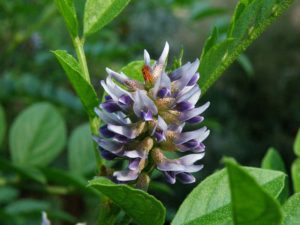A herb belonging to the pea and bean family, liquorice is cultivated for its underground stems that are used to flavour confectionery; it is also valued for its medicinal qualities.
Contents
Uses
The key uses are:
- confectionery
- medicine
- beverages
Confectionery
Glycyrrhiza glabra contains the compound glycyrrhizin, which is 50 times sweeter than sugar. It was well known by the ancient Greeks and Romans for its sweetness and is still a popular flavouring for confectionery today. Cultivated as a crop plant, the underground stems (rhizomes) of G. glabra are harvested and the juice extracted before being concentrated by boiling. The solid extract is used in confectionery, such as traditional liquorice sticks and wheels.
Pontefract cakes, or pomfrets, were originally made for their medicinal properties, but later became popular as confectionery; they were produced in Pontefract (Yorkshire, UK) from about 1660 to 1960. Anethole, a compound from the anise plant (Pimpinella anisum), is often used as flavouring for confectionery in place of, or in addition to,G. glabra extract.
Other uses
Liquorice is used in the production of drinks, for example as an ingredient in many root beers, and some brewers use it to colour stout (a dark beer made using roasted malt or barley).
It is also used in plug tobacco (a form of chewing tobacco), shoe polish and soap and as a fibre for the production of plastics and fibreboard. Spent liquorice rhizomes (underground stems) are used in fire-extinguishing agents and as compost for growing mushrooms.
Benefits
- Licorice lowers stomach acid levels, relieves heartburn and indigestion and prevents ulcer formation.
- Through its beneficial action on the liver, it increases bile flow and lowers cholesterol levels.
- In the respiratory system, its soothing and healing action reduces irritation and inflammation.
- Licorice enhances immunity by boosting levels of interferon, a key immune system chemical that fights off viruses.
- The phytoestrogens in Licorice have a mild estrogenic effect, making the herb potentially useful in easing certain symptoms of premenstrual syndrome (PMS), such as irritability, bloating and breast tenderness.
- Its anti-allergic property is useful in allergic rhinitis, conjunctivitis and bronchial asthma.
- When applied topically, Licorice can be used to fight dermatitis, eczema and psoriasis.
Cautions
It has been reported that excessive liquorice consumption can lead to cardiac dysfunction and severe hypertension.
Interactions
None are recorded.
Other names
liquorice, common liquorice, licorice, licorice-root, sweet wood liquorice
References
Source: Himalayawelness, http://www.himalayawellness.com/herbfinder/glycyrrhiza-glabra.htm
Kew.org, http://www.kew.org/science-conservation/plants-fungi/glycyrrhiza-glabra-liquorice

